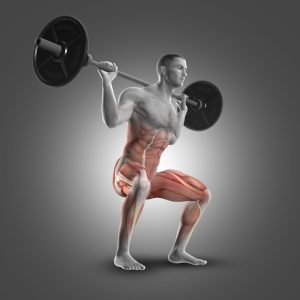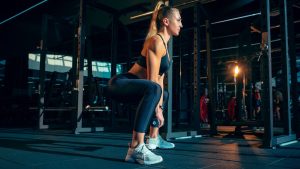Addressing tight hip flexors is crucial, especially as we age and our bodies adapt to various lifestyle demands. At 34, the hip flexors might feel tighter due to prolonged sitting, lack of mobility exercises, or specific activities.

Understanding Tight Hip Flexors
Hip flexors are a group of muscles responsible for lifting the knee towards the torso. When tight, they can limit mobility, affect posture, and even contribute to lower back pain. Hence, incorporating targeted exercises into your routine can alleviate discomfort and enhance flexibility.
Squats for Tight Hip Flexors
1. Bodyweight Squats:
These are a fantastic starting point. Stand with feet shoulder-width apart, lower down as if sitting back in a chair, and rise back up. Focus on form, keeping your back straight and chest up. This movement engages the hip flexors while encouraging flexibility.
2. Goblet Squats:
Holding a weight close to your chest, perform squats. This variation helps open up the hips by pushing them outward slightly, aiding in stretching the hip flexors.
3. Sumo Squats:
Widen your stance significantly, toes pointing outwards. Lower yourself down, targeting the inner thighs and hips. This stance provides a different stretch to the hip flexors compared to regular squats.

4. Split Squats:
With one foot forward and the other backward in a lunge position, lower your body until the back knee almost touches the ground. This engages the hip flexors more intensely.
Additional Tips
Stretching: Incorporate hip flexor stretches into your routine. Kneeling lunges or the pigeon pose in yoga can help release tension.
Mobility Work: Include exercises that promote hip mobility, such as leg swings, hip circles, or dynamic stretching.
Posture Awareness: Be mindful of sitting for extended periods. Take breaks, stand, or incorporate standing desks to avoid prolonged hip flexor contraction.
Remember, consistency is key. Gradually increasing the intensity and frequency of these exercises while maintaining proper form can significantly alleviate tightness in your hip flexors.
Let’s dive further into the details of addressing tight hip flexors for someone in their mid-thirties.
Understanding the Impact of Age
As we age, various factors contribute to tight hip flexors. Reduced physical activity, prolonged sitting, and even natural aging processes can lead to stiffness in these muscles. It’s essential to adopt a holistic approach that not only involves specific exercises but also encompasses lifestyle changes to counteract the effects of aging on hip flexibility.
Targeted Hip Flexor Stretches
Kneeling Hip Flexor Stretch: Kneel on one knee with the other foot forward, maintaining a 90-degree angle at both knees. Gently push your hips forward, feeling a stretch in the hip flexor of the kneeling leg.
Pigeon Pose: From a plank position, bring one knee forward towards the same side wrist, extending the other leg back. Lower your body and rest on your forearms, feeling a deep stretch in the hip flexors of the extended leg.
Standing Quad Stretch: While standing, bring one foot up towards your glutes, holding the ankle and gently pulling the foot closer. This stretches the front of the thigh and hip flexors.
Incorporating Dynamic Movements
Leg Swings: Holding onto a stable surface, swing one leg forward and backward, then side to side. This dynamic movement helps loosen up the hip joint and flexors.
Hip Circles: Stand with hands on your hips and rotate them in circles, focusing on the range of motion in your hips. This exercise promotes flexibility and mobility in the hip area.
Lifestyle Adjustments
Breaks from Sitting: If your job involves prolonged sitting, take breaks to stand, stretch, or take short walks. Even small movements can prevent the hip flexors from staying in a contracted position for too long.
Strength Training: Incorporate exercises targeting the core, glutes, and lower back. Strengthening these areas can alleviate pressure on the hip flexors and improve overall stability.
Final Thoughts
Addressing tight hip flexors is not just about specific exercises but also about making lifestyle adjustments to counteract the effects of modern sedentary living. Consistency in incorporating these exercises and lifestyle changes can significantly improve hip flexor flexibility and reduce discomfort associated with tightness.
External Resources:
WebMD – Strengthening Exercises for Hip Flexors: Explore strengthening exercises targeting the hip flexors.
Physiotherapy Room – Hip Flexor Stretching Exercises: Learn various hip flexor stretching exercises for improved flexibility.
Everyday Health – Yoga Poses for Tight Hip Flexors: Discover yoga poses specifically beneficial for tight hip flexors.
Mayo Clinic – Hip Flexor Stretch: Learn an effective hip flexor stretch.
Healthline – Exercises to Relieve Tight Hip Flexors: Explore a variety of exercises targeting tight hip flexors.
Harvard Health Publishing – The Best Hip Flexor Exercises: Discover some effective exercises recommended by Harvard Health for hip flexor flexibility.
Taking care of your body, especially the hips and lower back, can greatly impact overall mobility and comfort. Incorporate these exercises into your routine and notice the positive changes in your hip flexors over time.
By incorporating these exercises and adjustments into your routine, you’ll gradually experience increased flexibility and reduced tightness in your hip flexors, promoting better overall mobility and comfort.
Comparison tabular
Here’s a tabular breakdown comparing various exercises and stretches:
| Exercise Type | Description | Benefits |
|---|---|---|
| Bodyweight Squats | Stand with feet shoulder-width apart, perform squats focusing on form. | Engages hip flexors, encourages flexibility. |
| Goblet Squats | Hold weight close to the chest while performing squats. | Opens up hips, aids in stretching hip flexors. |
| Sumo Squats | Widen stance significantly, toes pointing outward, lower body down. | Stretches inner thighs and hips, targets flexors. |
| Split Squats | One foot forward, one backward in a lunge, lower body until back knee almost touches the ground. | Intensely engages hip flexors. |
| Kneeling Hip Flexor Stretch | Kneel on one knee, push hips forward to feel a stretch in the hip flexor. | Targets specific hip flexor muscles. |
| Pigeon Pose | From plank, bring one knee towards same side wrist, extend other leg back, lower body for a deep stretch. | Deep stretch for hip flexors and glutes. |
| Standing Quad Stretch | While standing, pull one foot towards glutes, stretching front of thigh and hip flexors. | Aids in flexibility of hip flexors. |
| Leg Swings | Holding onto a surface, swing leg forward/backward and side to side. | Loosens hip joint and flexors, dynamic movement. |
| Hip Circles | Stand with hands on hips, rotate them in circles to improve range of motion in hips. | Enhances flexibility and mobility in hip area. |
Exercise Benefits:
Strength-Based: Squats variations engage hip flexors while building lower body strength.
Stretching & Flexibility: Stretching exercises like kneeling hip flexor stretches and pigeon poses target specific muscles for flexibility.
Dynamic Movements: Leg swings and hip circles promote mobility and flexibility with dynamic movements.
Each exercise type offers distinct benefits, from strengthening and stretching to enhancing flexibility and mobility. Incorporating a mix can provide a holistic approach to relieve tight hip flexors effectively.
Wrapping up
Tackling tight hip flexors at 34 involves a blend of exercises and stretches, each serving a unique purpose. From squats to targeted stretches like the kneeling hip flexor stretch and dynamic movements like leg swings, these activities collectively aim to increase flexibility and alleviate discomfort.
Consistency is key. Incorporate these exercises into your routine, mindful of your body’s cues. Additionally, lifestyle adjustments such as taking breaks from sitting, incorporating strength training, and maintaining posture awareness complement these exercises, aiding in overall hip flexor health.
Remember, the goal isn’t just to alleviate tightness momentarily but to cultivate a lifestyle that promotes flexibility and mobility for the long term. By integrating these practices into your daily routine, you’re nurturing a healthier, more flexible body that’s better equipped to handle the demands of everyday life.

Hey there, it’s Mike Rrsq, the Editor-in-Chief over at Jsquat.com, and I’m absolutely obsessed with all things squat fitness! I’ve been lucky enough to get some serious recognition for my work in this field. With a solid background in the fitness and wellness industry, I’ve been there right from the get-go, helping shape this website into what it is today.
You see, I’m not just the boss around here; I’m also a passionate contributor. I love sharing my insights through my articles, and trust me, they’re not your run-of-the-mill stuff. Each piece I write is a labor of love, filled with my expertise and real-world experience in the fitness universe. So, if you’re into fitness and looking for some inspiration, you’re in the right place!
Related Posts
- Why Do Squats Make Me Feel a Stretch In My Hip Flexors: Explained)
Squats are a popular exercise that targets multiple muscle groups, including the quadriceps, hamstrings, and…
- The Best 3 Effective Squats patterns recommended for a 33-year-old to relieve tight hamstrings
At 33, finding the right squat variations to address tight hamstrings is pivotal for flexibility,…
- Are Squats Without Weight Effective? (Explained)
Are you wondering if squats without weight are worth your time? Learn the benefits and…
- Are Slow Squats Effective? (Explained)
Discover the truth about slow squats and their effectiveness in building leg strength. Read on…
- Should a 77-year-old incorporate squats to alleviate hip pain.
As we age, maintaining mobility and managing discomfort becomes increasingly important. For a 77-year-old dealing…
- Should squats with resistance band make You feel a burn in your hip abductor muscles?
Resistance bands have revolutionized the way we approach strength training, offering a versatile and effective…
- Why Do Squats Make Me Feel a Burn In My Hip Adductor Muscles: Explained)
Squats primarily target quadriceps, hamstrings, and glutes. However, many individuals experience a burning sensation in…
- Is performing squats effective in relieving lower back soreness
Lower back soreness is a prevalent issue that can significantly affect daily life and physical…
